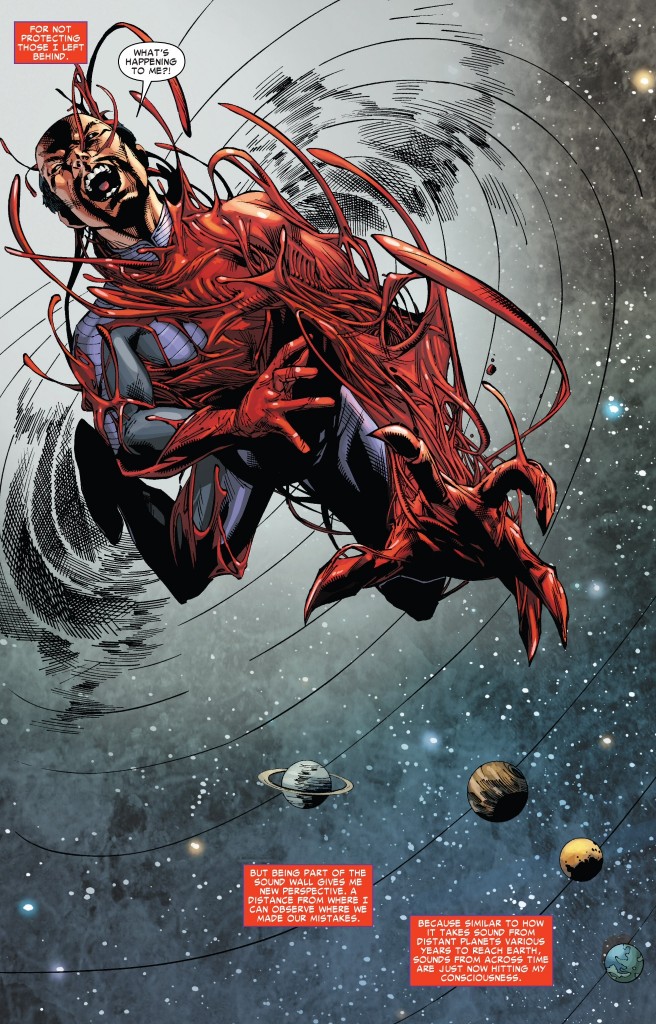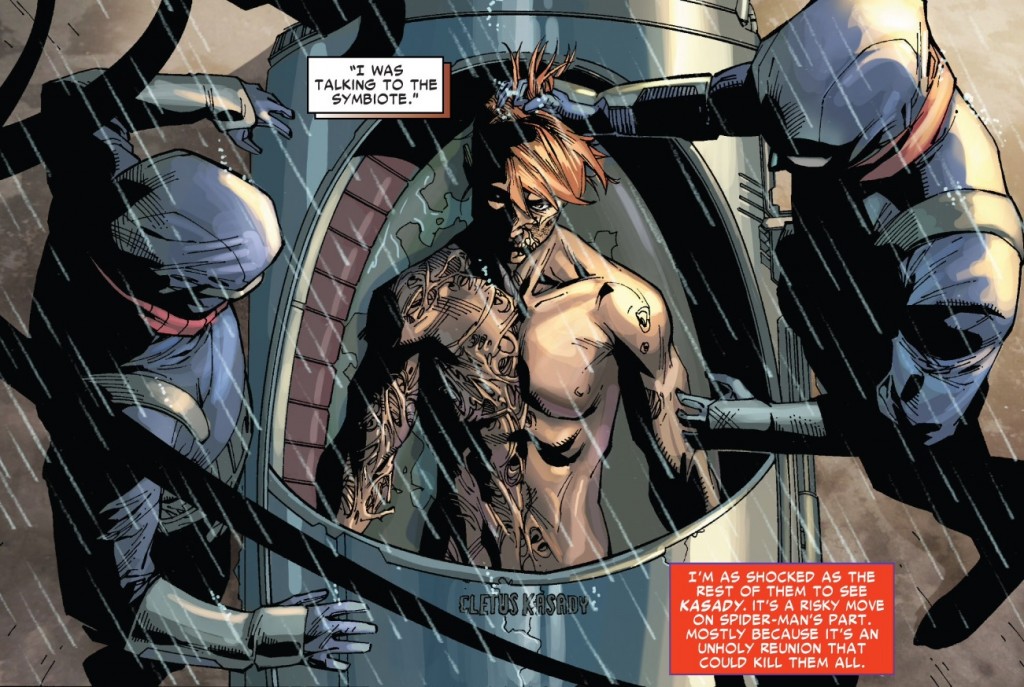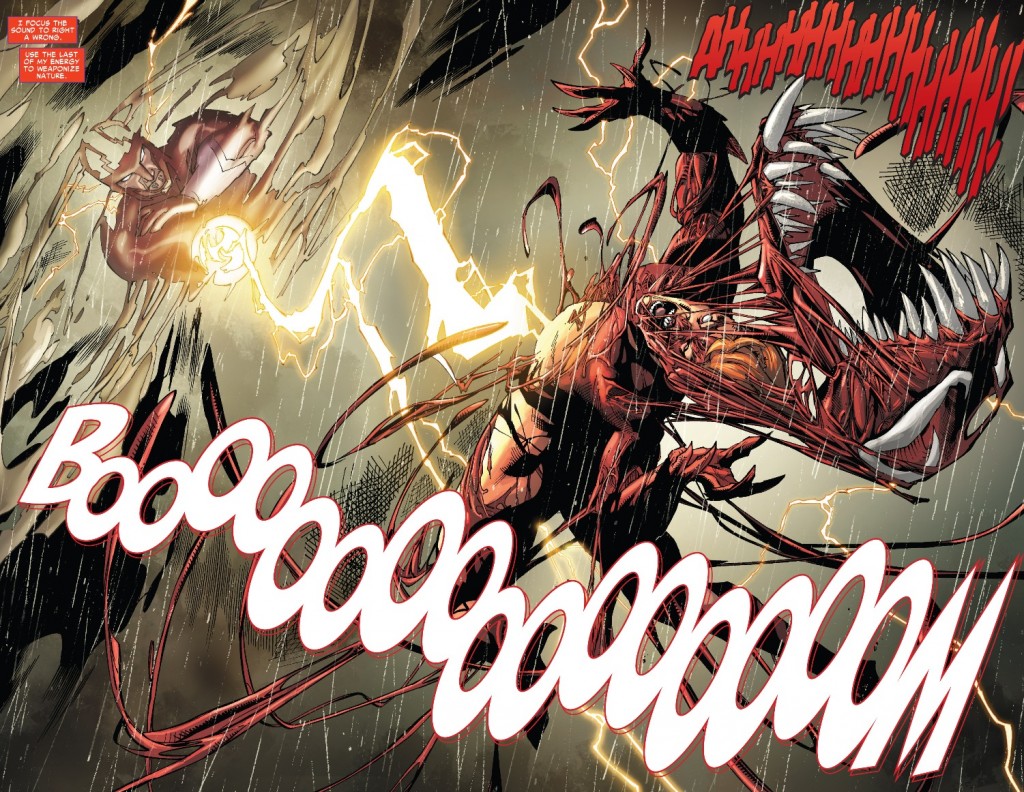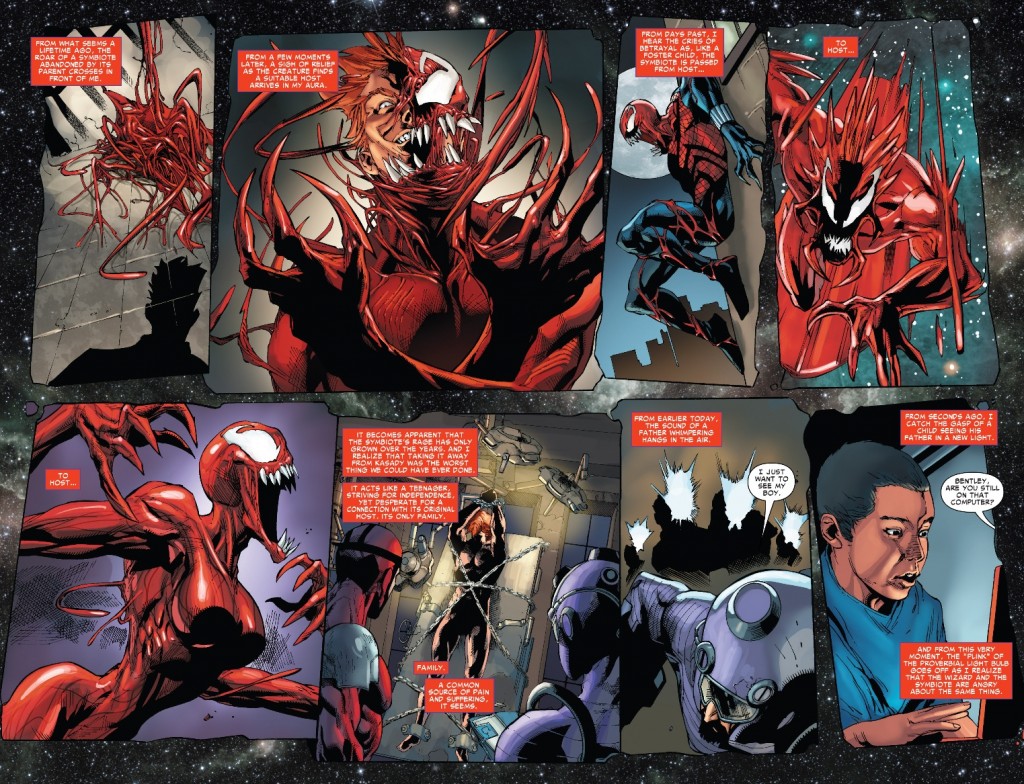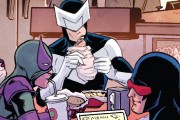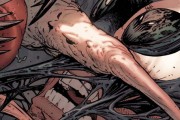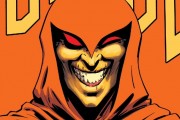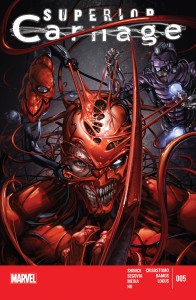 After building up the most non-Carnage Carnage story in the character’s history, Marvel had a change of heart (or “chickened out” depending on your opinion of Mr. Cletus Kasady) in the fifth and final part of its Superior Carnage mini-series, returning the psychotic symbiote to its status quo in anticipation of a what appears to be a Cletus-centric Superior Carnage Annual in February (since when does a mini-series get an annual?).
After building up the most non-Carnage Carnage story in the character’s history, Marvel had a change of heart (or “chickened out” depending on your opinion of Mr. Cletus Kasady) in the fifth and final part of its Superior Carnage mini-series, returning the psychotic symbiote to its status quo in anticipation of a what appears to be a Cletus-centric Superior Carnage Annual in February (since when does a mini-series get an annual?).
I have to admit that I’m a touch disappointed by Marvel’s reversal as I was really looking forward to a Superior Spider-Man/symbiote-possessed Wizard showdown in Superior Carnage #5 but I also realize that my sentiments represent a miniscule minority of Carnage fans. With that said, there were some sections of Superior Carnage #5 I quite liked, even if the issue’s conclusion left me flat, and even a touch confused.
Despite the fact that writer Kevin Shinick had not previously deployed this narrative technique earlier in the series, I found Klaw’s all-knowing observations from points “beyond” to be very gripping. From the onset of Superior Carnage, I was a huge fan of how Shinick unapologetically crafted a story that centered on two under-appreciated Silver Age villains in Wizard and Klaw. Whether this was done intentionally or not (and given some of the dialogue exchanges between Spider Ock and Wizard, I’m going to say it was intentional), I thought this was appropriate casting in a book where another Silver Age villain, Doctor Octopus, had taken over his rival Spider-Man’s body. A more “traditional” Spider-Man vs. Carnage story (where Peter is usually conflicted about crossing “the line” in trying to subdue the homicidal Kasady) would not have worked now that Otto is playing the part of Spidey. So Marvel had two choices: pump out a Rocky IV-esque “slobberknocker” of a fight between Spider Ock and Carnage and let us all count the bodies and wipe the blood off the walls when it was done; or go for something with a bit more nuance and intellect. Shockingly, Marvel went with the latter.
The use of Wizard and Klaw completely changed the tone of this series – in my opinion for the better. Rather than making this mini another Carnage killing-spree, Shinick and the rest of the creative team focused more on villains chasing one last quest for glory. Leading with Klaw’s narration in Superior Carnage #5, adds to the overall wistfulness of this book – words I never thought I would utter about a Carnage arc. There’s an absolute meta-quality to Klaw having to watch his best friend from a comic book generation ago be dominated by a character that is a byproduct of the industry’s excesses from the 1990s. There’s unquestionable irony to the fact that Carnage fans have been outraged by the lack of Kasady in this series in favor of Wizard and Klaw, while there are probably older fans befuddled by the presence of the Frightful Four in a series named after a one-note villain that was created in an era where every comic book cover featured chromium or holograms.
Klaw and Wizard do get some final moments in this series – Klaw regenerates long enough to save his friend from a gruesome ending once the symbiote re-bonds to Kasady, and Wizard gets some semblance of a reconciliation with his son (and his dementia has seemingly been reversed by the symbiote, but this is also the point where the book’s narration becomes a bit muddy and disjointed). But Shinick spends his last chapter attempting to find nuance in the symbiote’s story.
This is mostly an uphill battle for Shinick, though I did find the idea that the symbiote is more the perpetrator than the victim in the abandonment-department to be thought provoking. The fact that the symbiote jumps from host to host, looking for someone or something it can totally dominate, does eliminate any last inkling of sympathy I might have felt for it, but at the same time, it also makes its possession of Kasady seem all the more tragic. When the world was first introduced to Kasady in the 1990s, he was presented as a lost cause emotionally and mentally, and while that’s still very much the case, Shinick’s interpretation of the symbiote at least begs the question that maybe this character could have been redeemed if he was never exposed to the power of Carnage.
Alas, with Cullen Bunn (from Venom fame) writing the Superior Carnage Annual, I’m willing to wager that any nuance Shinick tried to instill in this character will be washed away, and the hokey, B-movie-style serial killing Kasady/Carnage will be front and center come February. Like the various hosts the symbiote has possessed over the years, I felt a little abandoned by just how abruptly Marvel returned to the status quo for Carnage here. I had higher hopes that Superior Carnage marked a bold new direction for not only Carnage, but for Wizard and Klaw as well, but with the exception of Klaw (who can probably be resurrected easily enough) everything is right back where it was before we even started. That’s unquestionably disappointing.
All images from Superior Carnage #5: Kevin Shinick, Stephen Segovia, Dan Mexia, Dennis Crisostomo & Don Ho

